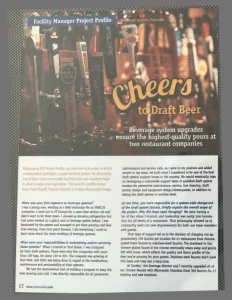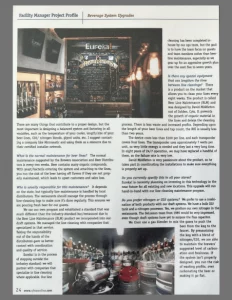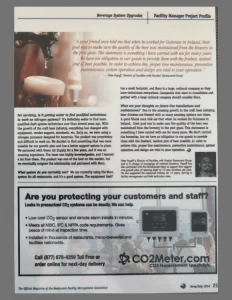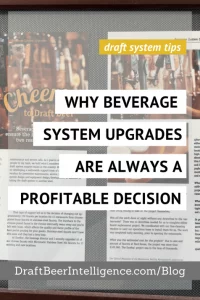One of our founders, Peter Popoff, wrote this article back in 2016 when he worked with Eureka Restaurant Group.
We post it here to showcase that the information you always see us writing about on the DBI blog or social media is genuinely timeless.
The message really never changes…
A draft system is only as good as its design, AND upgrading your beverage system will ensure the best quality pours…pint after pint.
We hope you enjoy this interview, and it answers some questions you may have about draft beer systems.
Here is the interview: ‘Cheers To Draft Beer’ where you learn why beverage system upgrades are always a profitable decision.
Beverage system upgrades ensure the highest quality pours at two restaurant companies.
Welcome to FM Project Profile, an interview style series in which a restaurateur spotlights a major facilities project. By discussing one of their most memorable facilities jobs, our members hope to share insight and inspiration.
This month’s profile comes from Peter Popoff, Facility Director at Eureka Restaurant Group.
When was your first exposure to beverage systems?
I was a young man, working as a field technician for an HVAC/R contractor. I went out to PF Chang’s for a warm beer service call and didn’t want to let them down. I showed up knowing refrigeration but had never worked on a glycol unit or beverage system before.
I was fascinated by the system and managed to get them pouring cold beer that evening. From that point forward, I did everything I could to learn more about the inner workings of beverage systems.
What were your responsibilities in maintaining and/or servicing these systems?
When I started at Yard House, I was intrigued by their draft systems. There were very few companies with more than 100 taps, let alone 130 to 250.
The company was growing at that time, and little was being done in regard to the installations, maintenance, and serviceability of their systems. We had the monumental task of building a program to keep the beer pouring and cold.
I was directly responsible for all preventive maintenance and service calls. As I grew in my position and added people to my team, we built what I considered to be one of the best draft system support teams in the country.
We would eventually take on developing a nationwide support team of qualified draft system vendors for preventive maintenance, service, line cleaning, draft system design, and equipment design/development, in addition to taking the draft system to another level.
At one time, you were responsible for a systemwide changeout of the draft system faucets. Briefly explain the overall scope of the project. Why did these need changing?
We were having a lot of fun when I started, and leadership was really into innovation for all levels of a restaurant. That philosophy allowed us to constantly seek out new improvements for both our team members and guests.
That type of support led us to the decision of changing out approximately 138 faucets per location for 41 restaurants from chrome-plated brass faucets to stainless steel faucets.
The drawback to the chrome plated faucet is the chrome eventually wears away and you’re left with brass, which affects the quality and flavor profile of the beer you’re pouring for your guests. Stainless steel faucets don’t have this issue and they last a long time.
At Eureka!, the beverage director and I recently upgraded all of our chrome faucets with Micromatic Stainless Steel 304 faucets for 17 existing and new locations.
How long did it take to complete all the spigot replacements?
The first time I completed this type of project, it took us six to nine months to get all of the faucets replaced, with the assistance of our line cleaning vendors.
The Eureka! project took us a week to complete for 17 restaurants with an average of 34 taps per location. We were able to complete this project quickly due to our operations team being willing to take on the project themselves.
Was all the work done at night without any downtime to the restaurants?
There was no downtime needed for us to complete either faucet replacement project. We coordinated with our line cleaning vendors or used our operations team to install them for us. The work was completed early morning, prior to opening the restaurants.
What was the estimated cost for the project?
Due to size and amount of faucets at Yard House, the project was more than $100,000. The Eureka! project was in the tens of thousands.
After completion, was there a payback on the investment either monetarily, through a better product or through lower maintenance costs?
At Eureka!, we have an average of 34 taps per location and our beverage director does an amazing job of bringing in high quality draft beer.
Each location has a specialized beer list and about 20 cool rotating beers. Many of these are limited quantity, so this type of upgrade to our system adds value to every pint we pour, and it really does separate us from our competitors.
The monetary payback is not having to replace the chrome faucets every year to 18 months. The biggest payback to the Eureka! team is knowing each and every pint we serve our guests is of the highest quality.
What were the major problem(s) encountered? How were these addressed?
There were no major issues with the execution of the projects. It all flowed like a perfect pour of Pliny the Younger into a clean pint glass.
What were your main takeaways from this project?
Quality! We all know the restaurant industry is highly competitive and margins are tight. Working for a company that is willing to spend money to put out a quality product for their guests is priceless.
In your opinion, what is the biggest maintenance or installation issue with beer and/or soda lines?
The two largest issues are serviceability and system design. We all understand serviceability, but many times, it’s forgotten throughout the construction process.
Once the building is handed over to Facilities and Operations, we are responsible with coordinating maintenance and service to equipment with limited access or improper design. The system design is critical because the goal is to not only pour quality draft beer but also yield as much beer as possible per keg.
There are many things that contribute to a proper design, but the most important is designing a balanced system and factoring in all variables, such as the temperature of your cooler, length/size of your beer lines, C02/ nitrogen blends, glycol units, etc.
I suggest contacting a company like Micromatic and using them as a resource due to their certified installer network.
What is the normal maintenance for beer lines?
The normal maintenance suggested by the Brewers Association and Beer Distributors is every two weeks.
Beer contains many organic compounds. With yeast/bacteria entering the system and attaching to the lines, you run the risk of the beer having off-flavors if they are not properly maintained, which leads to upset customers and sales loss.
Who is usually responsible for this maintenance?
It depends on the state, but typically line maintenance is handled by local distributors. The restaurants should manage the process through line cleaning logs to make sure it’s done regularly. This ensures we are pouring fresh beer for our guests.
We ran our own program and established a standard that was much different than the industry standard bar/restaurant due to the Beer Line Maintenance (BLM) product we incorporated into our draft systems. We managed the line cleaning with companies that specialized in that service. Taking the responsibility out of the hands of the distributors gave us better control with coordination and quality of service.
Eureka! is in the process of stepping outside the industry standard; we will partner with companies that specialize in line cleaning where applicable. Our line cleaning has been completed in-house by our ops team, but the goal is to have the team focus on guests and team members rather than beer line maintenance, especially as we gear up for an aggressive growth plan over the next five to seven years.
Is there any special equipment that can lengthen the time between line cleanings?
There is a product on the market that allows you to clean your lines every eight weeks. The product is called Beer Line Maintenance (BLM) and was designed by David Middleton out of Golden, Colorado.
It prevents the growth of organic material in the lines and delays the cleaning process. There is less waste and increased profits. Depending upon the length of your beer lines and tap count, the ROI is usually less than two years.
The device costs less than $100 per line, and each transponder covers four lines. The transponder uses approximately 7 watts per unit, so very little energy is needed and they last a very long time. In eight years of 24/7 operation, we may have replaced a handful of them, so the failure rate is very low. David Middleton is very passionate about the product, so he takes part in coordinating the installations to make sure everything is properly set up.
Do you currently specify this in all your stores?
Eureka! is currently planning on investing in this technology in the near future for all existing and new locations. This upgrade will run hand in hand with our line cleaning maintenance program.
Do you prefer nitrogen or CO2 systems?
We prefer to use a combination of both products with our draft systems. We have a bulk C02 tank and a nitrogen processor. Yes, we produce our own nitrogen in the restaurants. The DeLorean team from 1985 would be very impressed, even though draft systems have yet to surpass the flux capacitor.
We then use a gas blender to mix the gases to push the beer from the keg to the faucet. By pressurizing the keg with a blend of nitrogen/C02, we are able to maintain the brewers’ suggested level of carbonation and freshness. If the system isn’t properly designed, you run the risk of wasting profits, over carbonating the beer, or making it go flat.
For servicing, is it getting easier to find qualified technicians to work on nitrogen systems?
It’s definitely easier to find more qualified draft system technicians now than several years ago. With the growth of the craft beer industry, everything has changed with equipment, vendor support, standards, etc.
Early on, we were using a nitrogen processor designed for hospitals. The product was proprietary and difficult to work on. We decided to find something that was more scalable for our growth plan and has a better support system in place.
We partnered with Green Air Supply for a few years, and it was an amazing experience. The team was highly knowledgeable, and I learned a lot from them. The product was one of the best on the market, but we eventually outgrew the relationship and partnered with Nuco.
What system do you currently use?
We are currently using the Nuco system for all restaurants, and it’s a good system. The equipment itself has a small footprint, and Nuco is a large, national company so they have technicians everywhere. Companies that want to consolidate and partner with a large national company should consider Nuco.
What are your thoughts on future line installations and maintenance?
Due to the amazing growth in the craft beer industry, beer drinkers are blessed with so many amazing options out there. A good friend once told me that when he worked for Guinness in Ireland, their goal was to make sure the quality of the beer was maintained from the brewery to the pint glass. This statement is something I have carried with me for many years.
We don’t control the breweries, but we have an obligation to our guests to provide them with the freshest, tastiest pint of beer possible. In order to achieve this, proper line maintenance, preventive maintenance, system operation, and design are vital to your operation.
Are you ready to make some upgrades to your beverage system(s)?
Here at Draft Beer Intelligence, we always want to help you deliver the perfect pour day after day. And to make sure that your draft beer systems produce GREAT tasting beer and MAXIMIZE profits!
Contact us here anytime if you need a draft beer system design, installation, ongoing maintenance, or service nationwide. Together, let’s keep “DOING BEER JUSTICE!”






